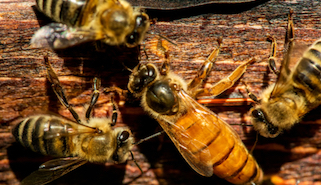News
Nov, 30 2021
Queens – Why Bother?

Queens – Why Bother? BY ANDREW STRATFORD (Nov 30, 2021).
I didn’t get into beekeeping, initially, for the love of bees. It was more about trying to earn a living.
My colleague when I started, Cliff Van Eaton, said to me that the best beekeepers he knew were people who understood the bee’s biology and tried to work with a good understanding of the bees themselves. The goal was to look after the bees – farm them essentially in such a way that they would thrive and in turn look after us. Our business mantra became, ‘caring for our bees, our people and our environment’. The result for us is that we almost always have great strength colonies when we need them. Generally, too many bees are our problem rather than not enough.
My AP2 work places me in the situation of being able to see into a lot of different beekeeper’s hives in some amazing places. I’ve been out going through hives the past couple of months and the major negatives are when I look through abandoned hives, 98% of which are dead. The background stories must be as sad as the empty hives.
Time to requeen? Replacing poor laying queens with younger, better laying stock is a fast way to improved production, but often overlooked by beekeepers. Above: a failing queen, below: a productive queen.
Where there are bees, I’m seeing colonies that have been well managed in terms of their varroa control, but are often lacking in the quality of their queens. This shows itself in how variable the colony strengths are. Small colonies with poor laying patterns from old queens, through to beautiful young queens with pumping colonies, and everything in between.
In other hives I see brood full of sacbrood or chalkbrood, the failure to requeen with good genetic stock. We as an industry have put a lot of time recently into understanding and controlling varroa but very little time into annual requeening – relatively easy by comparison. Good basic bee husbandry. It’s tough making money in this industry currently, so it’s essential we get the A, B, Cs right.
One of the four main keys to making beekeeping a whole lot easier for yourself is having a process in your beekeeping of annually requeening. It’s really not that difficult to achieve, but requires that you do a bit of planning and have mated queens or queen cells available for when you need them. Part of the planning means you have to contact someone who produces good genetic queen stock and place an order. Cells are cheaper and requeening your entire business is not that difficult if you do it at the right time. Putting a couple of days aside at the right time can save you a massive amount of work and means the following season is so much more straightforward.
So, what can you do?
- Find a good queen breeder reasonably close to your business and talk with them about what you want to do. Can they supply what you need? A tip…if your colonies are full of sac or chalk brood – maybe look to buy your cells / queens from a different supplier from the one you’ve always used.
- Work out when the best time is for you to ‘blanket’ requeen your colonies – you’ll need to put a bit of time aside in what could be an already busy period. Believe me, the cost of not doing it is far greater than making that time available. Usually, protected queen cells are the way you can achieve this blanket approach.
- Understand your requeening ‘windows’ and plan your other work around this.
- Order your cells and talk with your queen breeder about how to handle them and care for them best. Timing is critical so ensure this work is priority and you handle your cells with care.
- Do the work. If you haven’t done it before, consider learning from someone who knows how. The results will speak for themselves!
Andrew Stratford is an apiculture consultant with 30 years beekeeping experience, including as a current business owner. He forms part of MyApiary’s management advisory team.
See the original article at: https://www.apiaristsadvocate.com/post/queens-why-bother
